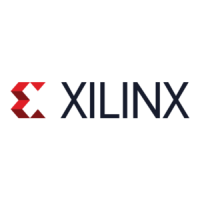160 www.xilinx.com ChipScope Pro Software and Cores User Guide
UG029 (v14.3) October 16, 2012
Chapter 5: ChipScope Engine Tcl Interface
::chipscope::csejtag_tap set_irlength
This subcommand sets the instruction register (IR) length of a single device in the current
JTAG chain. The
IR length is used to determine the amount of padding required to shift an
instruction into a device register. TAP shift and navigate operations do not work until all
devices have the IR lengths set up correctly. The
::chipscope::csejtag_tap
autodetect_chain
subcommand automatically sets up IR lengths for all devices in the
chain that support the
IDCODE command.
Note: The JTAG target must be locked by using the ::chipscope::csejtag_target lock
subcommand before calling this subcommand. Also, the device count must be set prior to calling this
subcommand using the ::chipscope::csejtag_tap set_device_count.
Syntax
::chipscope::csejtag_tap set_irlength handle deviceIndex irLength
Arguments
Returns
An exception is thrown if the subcommand fails.
Example
Set the IR length of the device at index 0 to 11 bits.
%::chipscope::csejtag_tap set_irlength $handle 0 11
Back to list of all CseJtag Tcl Commands
Table 5-32: Arguments for Subcommand ::chipscope::csejtag_tap set_irlength
Argument Type Description
handle
Required
Handle to the session that is returned by
::chipscope::csejtag_session create.
deviceIndex Device index (0 to n-1) in the n-length JTAG chain.
irLength Length of the IR (in bits)

